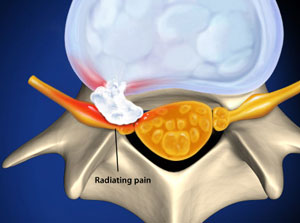Degenerative Disc Disease
What is Degenerative Disc Disease?
 Degenerated Spinal Disc © Viewmedica
Degenerated Spinal Disc © Viewmedica
Degenerative Disc disease is a chronic and often painful condition. This condition happens when one or more of the vertebral discs (cushions between the vertebrae) become damaged and weakened and no longer work as shock absorbers for the movement of the spine.
Degenerative disc disease can be a result of the natural ageing process or injury to the back at any age. It begins when small tears appear in the disc wall. The tears cause pain in the back at the site of the tear.
Gradually the scars heal, causing scar tissue. This scar tissue is not as strong as the original disc wall.
If this process of tearing, scarring and weakening continues over time, the nucleus of the disc becomes damaged and loses some of its water content.
The water inside the disc is what enables it to act as a shock absorber. Without the shock absorber, the vertebrae above and below the damaged disc start to slide together and in turn, the facet joints (areas where the vertebral bones touch), twist into an unnatural position. Eventually, bone spurs may form, which, if left untreated can lead to spinal stenosis (pinching of the spinal cord and sciatic nerve).
Degenerative Disc Disease Symptoms
- Back pain - strong pain may come and go
- Pain, numbness or tingling in the legs (sciatica)
- Pain may be worse when bending, twisting or sitting
- Lying down may relieve pain
Specialist orthopaedic and neurosurgeons work together in an interdisciplinary team at the Gelenk Klinik. They diagnose Degenerative Disc Disease via modern devices and expert clinical investigation. Minimally invasive surgical techniques reduce scarring from the incision and give a fast recovery time.




